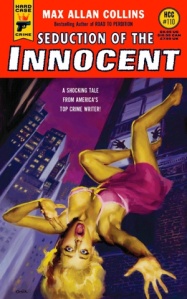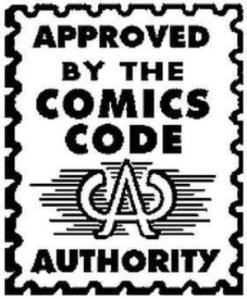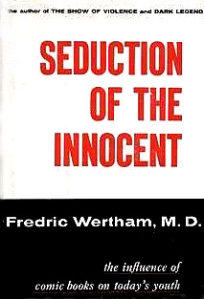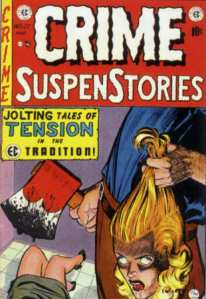 Imagine if you will: mid-20th century Manhattan, a country fresh off the victory of World War II, and an industry at the height of its Golden Age. Spring, 1954 should have been nothing but sunshine and daisies for the Comics industry, but in history nothing seems to ever be as it “should”…and in an America that had gone black-list crazy, the comics industry quickly became the target of a modern witch hunt. Accusations of corrupting America’s youth flew faster than bullets had in the War, and the guns were pointed firmly at burgeoning and well-established comics professionals alike. In a purposeful parallel, Seduction of the Innocent is also the title of a text written by prominent pop psychiatrist Dr. Frederic Wertham, who led the march against comics with the “evidence” in his book as ammunition.
Imagine if you will: mid-20th century Manhattan, a country fresh off the victory of World War II, and an industry at the height of its Golden Age. Spring, 1954 should have been nothing but sunshine and daisies for the Comics industry, but in history nothing seems to ever be as it “should”…and in an America that had gone black-list crazy, the comics industry quickly became the target of a modern witch hunt. Accusations of corrupting America’s youth flew faster than bullets had in the War, and the guns were pointed firmly at burgeoning and well-established comics professionals alike. In a purposeful parallel, Seduction of the Innocent is also the title of a text written by prominent pop psychiatrist Dr. Frederic Wertham, who led the march against comics with the “evidence” in his book as ammunition.
The third in a trilogy of “true-crime” fiction by Max Allan Collins, Seduction of the Innocent brings the events of this crusade into brilliant detail, with a dash of heightened drama and a twist that only Collins’ masterful pen can provide. The book reads so smoothly and quickly that it’s worth keeping around for a second or third perusal lest readers miss clues to the case in favor of savoring the brightly drawn-to-life characters and landscapes, and the gory details of a real-life murder re-imagined. Collins is perhaps most popular for his graphic novel Road to Perdition, which was made into a major motion picture in 2002.
In Seduction, Collins doesn’t simply write about the comics of the 1950’s, he makes use of their conventions, even starting each chapter with a comics-style illustration, drawn by comics artist Terry Beatty, that shows the climax of the events to come. Some of the illustrations give away major plot surprises, but they work because readers are then free to focus on Collins manipulation of language and strong-jawed protagonist, Jack Starr. In fact, before the resolution of the mystery at hand, the story is put on pause for a three-page graphic breakdown of the suspects, all brought to life by Beatty’s delightfully gritty art style.
Those familiar with comics of the time period, or a good hard-boiled detective story will revel in the way Collins brings classic elements to a modern world. The book balances its scope perfectly, never biting off more than it can chew nor hyper-focusing on the fictional events of the case. It does not shy away from gory murder details, nor sexuality, nor violence, nor language…the result is a near-perfect journey of pulp fiction-y goodness. Beyond that, however, the book is relevant in a way Collins could never have guessed–now that the debate of violence in entertainment has once again become a hot-button issue, Seduction of the Innocent reminds readers that history repeats itself, and when the going gets rough, the censors get going. Perhaps Collins planned this on some level, however, as Jack Starr occasionally reminds those around him comics are only the scapegoat of the hour, and takes a moment among the excitement of the murder case’s resolution to quip “It’s not comics that are violent. It’s TV!”–an obvious commentary on the fact that any form of entertainment draws critics once it gets popular enough.
At the end of Seduction of the Innocent, Collins includes an epilogue titled “Tip of the Fedora”. This is less an epilogue and more an annotated bibliography, showing how much loving hard work and research went into the creation of this book. “Tip of the Fedora” separates fact from fiction, explaining which elements of the book stayed true to history and which may have embellished a bit (or a lot, where it was necessary). Collins also uses this section to recommend further reading, both in fiction and non-fiction, about the 1950s backlash against the comics industry, and the creation of the Comic’s Code Authority that nearly destroyed comic books altogether. 
While Seduction of the Innocent can be called the final installment in a trilogy, there is no hint of missing on important plot or character development by starting here and continuing with the other books. He writes, in “Tip of the Fedora” “The Jack and Maggie Starr mysteries were conceived as a trilogy. That’s not to say I might not return to the characters, should readers indicate a desire to do so, rather to indicate I initially had three topics in the history of comics that I wanted to explore”. If the other two books are even a fraction as good as this one, this reader at the very least is indicating a desire for more Jack and Maggie, and soon!
Seduction of the Innocent is written by Max Allan Collins, and published by Hard Case Crime.
Jen Schiller
Staff Writer
Twitter.com/Jenisaur


















Great review!